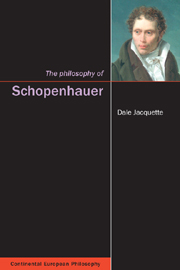Book contents
- Frontmatter
- Contents
- Dedication
- Preface
- Acknowledgements
- A note on texts and terminology
- Abbreviations
- Introduction: Schopenhauer's life and times
- 1 Schopenhauer's idealism
- 2 Empirical knowledge of the world as representation: from natural science to transcendental metaphysics
- 3 Willing and the world as Will
- 4 Suffering, salvation, death, and renunciation of the will to life
- 5 Art and aesthetics of the beautiful and sublime
- 6 Transcendental freedom of Will
- 7 Compassion as the philosophical foundation of morality
- 8 Schopenhauer's legacy in the philosophy of Nietzsche, Heidegger and the early Wittgenstein
- Notes
- Bibliography and recommended reading
- Index
5 - Art and aesthetics of the beautiful and sublime
- Frontmatter
- Contents
- Dedication
- Preface
- Acknowledgements
- A note on texts and terminology
- Abbreviations
- Introduction: Schopenhauer's life and times
- 1 Schopenhauer's idealism
- 2 Empirical knowledge of the world as representation: from natural science to transcendental metaphysics
- 3 Willing and the world as Will
- 4 Suffering, salvation, death, and renunciation of the will to life
- 5 Art and aesthetics of the beautiful and sublime
- 6 Transcendental freedom of Will
- 7 Compassion as the philosophical foundation of morality
- 8 Schopenhauer's legacy in the philosophy of Nietzsche, Heidegger and the early Wittgenstein
- Notes
- Bibliography and recommended reading
- Index
Summary
That the Idea comes to us more easily from the work of art than directly from nature and from reality, arises solely from the fact that the artist, who knew only the Idea and not reality, clearly repeated in his work only the Idea and not reality, separated it out from reality, and omitted all disturbing contingencies. The artist lets us peer into the world through his eyes. That he has these eyes, that he knows the essential in things which lies outside all relations, is the gift of genius and is inborn; but that he is able to lend us this gift, to let us see with his eyes, is acquired, and is the technical side of art.
(WWR 1: 195)Philosophy of art
In Schopenhauer's aesthetics we discover a lighter side of his philosophy. Although his moral pessimism continues unabated as a recognition of the inevitable conflicts among the Will's objectifications, Schopenhauer is not as obsessively concerned with the facts of death and human misery when he turns to topics of aesthetic pleasure and enjoyment of the fine arts.
Whether Schopenhauer's metaphysics of Will as thing-in-itself is brilliant or delusional, the distinction between the world as Will and as representation supports a philosophy of art that is unique in the history of aesthetics. Schopenhauer's theory is worth studying for two reasons, even if we do not accept his metaphysics of Will and representation or his heterodox interpretation of Platonic Ideas.
- Type
- Chapter
- Information
- The Philosophy of Schopenhauer , pp. 145 - 179Publisher: Acumen PublishingPrint publication year: 2005

